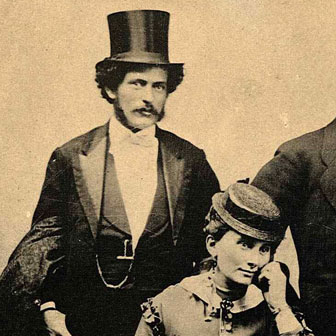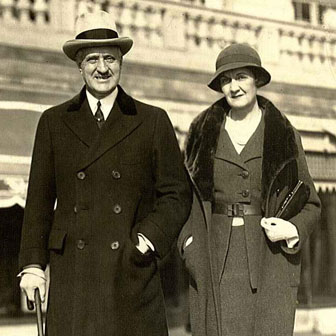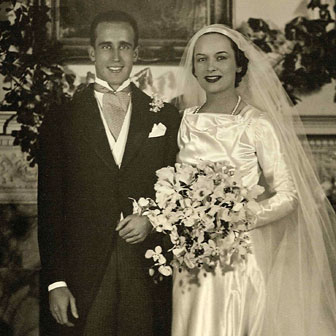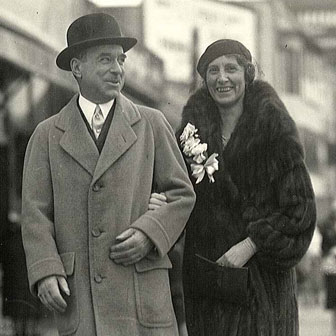H. J. and Sarah Heinz
Howard and Elizabeth Rust Heinz
H. J. “Jack” Heinz II and Joan Diehl
Clifford and Vira Heinz

H. J. and Sarah Heinz
H. J. Heinz was born in 1844 in the Birmingham section of Pittsburgh, the son of Anna Margaretha and John Henry Heinz. His father ran a brickyard in Sharpsburg; part of that property was used as a household garden by his mother.
At the age of 14, Henry was already tending his own section of the garden and was developing a list of customers. He attended Duff’s Mercantile College and thoroughly familiarized himself with good, sound business practices. Soon, he began peddling prepared horseradish.
By 1869, Heinz was ready to formalize his business and did so by entering a partnership with L. Clarence Noble and forming Heinz & Noble. Their first product was, of course, horseradish, sold in clear bottles to prove that, unlike some foods, it was totally unadulterated. In the same year, he married Sarah Sloan Young, known as Sallie, who was a first-generation American, her family hailing from County Down, Ireland, where they owned a mill. Together they had four children: Irene, Howard, Clarence and Clifford.
Disaster struck in 1875. Tight money, a national financial panic and the purchase of huge stocks of cucumbers and cabbage led to the bankruptcy of the young company. Despite seemingly impossible odds, Henry regrouped and forged ahead with the emotional and modest financial support of Sarah. He vowed to repay every debt, which he considered moral obligations, and did just that. By February 1876, he joined his brother John and cousin Frederick and launched the F. & J. Heinz Company.
By 1888, Heinz bought out his partners, established a relationship with retailers in England and embarked on construction of a factory on the Allegheny River that would embody the best of his business acumen and his Christian principles. His benevolent management style made the H. J. Heinz company a pioneer in labor relations. Workers were well treated and afforded comforts and conveniences including free manicures and rooftop gardens for both men and women.
In 1894, the greatest tragedy of Henry’s life occurred—the death of his dearly beloved wife, Sallie. She died from double pneumonia, leaving a broken husband and bereaved children behind.
Despite his profound loss, Heinz worked tirelessly against a large segment of the processed food industry to gain passage of the Pure Food and Drug Act in 1906. It inaugurated the modern food industry and guaranteed purity to all consumers.
Years of hard work and innovation had made Henry John Heinz and his products internationally known and respected. In 1919, in the year of the 50th anniversary of the founding of Heinz & Noble, H. J. Heinz died of pneumonia at his home, Greenlawn, in Pittsburgh. He had instilled a sense of duty and obligation in his children that would bear fruit for generations to come.

Howard and Elizabeth Rust Heinz
Howard Covode Heinz was born in 1877 to H. J. Heinz and his wife, Sallie. Raised with an ethic of hard work and community obligation, he worked in the company’s factories and salting stations around the country as a youth. Howard graduated from Yale in 1900 and began his executive career.
In 1906, Howard married Elizabeth Granger Rust from Saginaw, Michigan. Elizabeth’s family, the Rusts, were involved in the lumber business in Michigan. As a young woman, she attended the fashionable Ogontz School for Young Ladies near Philadelphia, and she was an avid bridge player. In 1908, their son H. J. “Jack” Heinz II was born, followed in 1913 by another son named Rust.
During Howard’s tenure as president of the Heinz Company, World War I broke out and he would come to have a role in the aftermath of the hostilities. Beginning in 1917, Howard served as United States Food Administrator for Pennsylvania. At the end of the war, in December 1918, Herbert Hoover, director of food relief, cabled Howard and asked him to serve as Director-General of American Relief Administration for Southeast Europe and Asia Minor. Howard willingly accepted and departed for Constantinople, where he would remain until his father’s death in May of 1919 called him home. During his time away, Elizabeth, or "Betty," as Howard called her, wrote frequently and was very supportive.
The decades of the 1920s and 1930s saw Howard at the top of his game. The ’20s saw expansions to thousands of acres, 69 branch offices and nearly 1400 salesmen. Howard controlled the finances and traveled extensively to oversee this vast international empire.
With the onset of the Great Depression, Howard’s exceptional business skills, exercised during the ’20s, paid off. The company had no debt and was actually able to expand its markets and its workforce at a time when other companies were closing their doors. In fact, it was during this time that son Jack was off to Australia to set up a new factory.
Also during the 1930s, Jack and Rust were completing their educations and beginning their own careers. Jack would apprentice himself at the company, and Rust began designing automobiles in Pasadena, California. He designed the Comet, a delivery vehicle for the Heinz Company, and the Phantom Corsair, a futuristic vehicle with the ultimate in safety features. The car was even featured in the movie The Young in Heart with Paulette Goddard and Douglas Fairbanks, Jr. Ironically, there was only ever one Corsair made, as Rust lost his life in an automobile accident in July of 1939.
As the 1940s approached, war loomed on the horizon for Europe and tragedy again befell the Heinz family. This time, it would have to be H. J. Heinz II who would see the company through. Howard died in early 1941 after suffering a stroke following a medical procedure in Philadelphia. With his will, the Howard Heinz Endowment was established.
Elizabeth Heinz continued to live in their Morewood Heights home in Pittsburgh until her death in 1952.

H. J. “Jack” Heinz II and Joan Diehl
Born in 1908, Jack Heinz would live to see two world wars, the Great Depression, the vast international expansion of the Heinz Company and a renaissance in the city of Pittsburgh.
He was educated at Choate, Yale and Cambridge, but, like his father before him, he worked summers in the pickling and salting stations for the company. He then joined the sales force in England and grew to have a happy and profitable association with the UK.
In 1935, Jack married Joan Diehl, a pioneering aviatrix, and the mother of their only child, H. J. Heinz III. They established their home at Rosemont Farm in the Fox Chapel suburb of Pittsburgh. While Jack was active in the business world, Joan was an industrial designer and a fine artist. They divorced in 1942, shortly after Jack became president of the company following the death of his father.
His task to lead the company at a time of war was a daunting one. He made five trips to England during the war once when the company’s Harlesden plant was bombed and on several occasions at the request of the British government. He was tapped to assist England with its food shortages and also toured the Netherlands to assist that nation with food aid. Like his father after World War I, Jack was instrumental in assuaging the dire food situation in war-ravaged Europe.
The company under his leadership actively participated in the war effort. The main plant in Pittsburgh was retooled for a time to manufacture glider planes for the Department of the Army and, overseas, the Harlesden plant developed innovative strategies to utilize what food was available in England to its best advantage.
As a civic leader, Jack served as chairman of the United War Fund and routinely gave speeches with the themes of food conservation, rationing and food allocations. After the war, he served as chairman of the Community Chest, which later became the United Way, criscrossing the country, encouraging people to give and give generously.
But Jack Heinz was not just the president of an ever-growing company. He was an avid skier and an art collector, he traveled extensively all over the world and he was a thoughtful and dedicated philanthropist. In 1953, he married Drue Maher, who shared these interests and also had her own areas in which she worked, often acting as a theatrical angel. The arts in general, and literature and writers in particular, received great attention. She founded Ecco Press in 1971 and the Drue Heinz Literature Prize in Short Fiction, which is awarded annually by the University of Pittsburgh Press. It was as a philanthropist that Jack Heinz would make significant contributions to the city of Pittsburgh. Following the war, he teamed up with Richard King Mellon and Mayor David Lawrence for Renaissance I—a plan to revitalize Pittsburgh and its image from old 19th-century ways to modernity. Smoke-control ordinances went into effect, ending years of pitch blackness at noon caused by soot and smoke from the steel mills.
Through his chairmanship of the Howard Heinz Endowment, Jack Heinz undertook the rebirth of the Lowe’s Penn Theater, originally a movie theater. He worked to convert it to a home for the Pittsburgh Symphony. The building, known now as Heinz Hall, has served as a model for urban redevelopment.
Despite advancing years and encroaching illness, Jack continued his dynamic leadership at the H. J. Heinz Company. Among the more notable achievements was the development of a baby food factory in mainland China. He was personally on hand for the opening, where the Chinese, who have a respect for lineage, were pleased to see that there was actually a Heinz behind the Heinz Company name.
In 1987, Jack Heinz succumbed to cancer, passing the reins of the company outside the family for the first time and the leadership of the family’s philanthropy to his son, H. John Heinz III.
Drue Heinz continues her philanthropy in the United States and Europe. Recently, she underwrote part of a major renovation of the National Portrait Gallery in London and was instrumental in the establishment of the Drue Heinz Study Center at the Cooper-Hewitt National Design Center.

Clifford and Vira Heinz
The youngest of H. J. Heinz’s sons was born in 1883 and grew up in the shadow of three older siblings. In 1905, he entered Lafayette and eventually moved to a career with the H. J. Heinz Company’s Pittsburgh works. He married Vira Ingham of Pittsburgh in 1932 and died a scant three years later in Palm Springs.
Vira would never remarry, but she would embark on a career of philanthropy that would go on for more than four decades. She worked in the homefront war effort during World War II and went on to participate in the founding of the Civic Light Opera, serve on the boards of the Pittsburgh Opera and Symphony Society and become the first woman trustee of Carnegie Mellon University.
Her devotion to Pittsburgh and the region she called home continued even after her death in 1983. As part of her will, she established the Vira I. Heinz Endowment, which continues her generous work in giving back to Pittsburgh and Western Pennsylvania.
